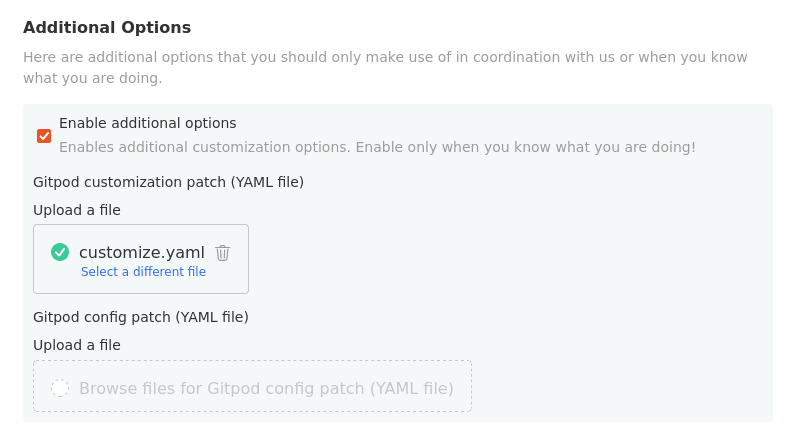Applying custom annotations, labels and environment variables
⚠️ Gitpod Self-hosted has been replaced with Gitpod Dedicated, a self-hosted, single-tenant managed service that runs in your private cloud account but is managed by us.
Try out Gitpod Dedicated.
In this guide, we expect you to have a cluster up and running that meets the requirements and has the required components installed and configured (at least cert-manager is needed).
This guide assumes that you are using our default installation method from our installation guide.
Rationale
There are times when it is necessary to add custom annotations, environment variables and labels to your installation in order to add it to your environment. For example, one may need to support specific monitoring and observability software or want to target a specific load balancer type.
Configuration
Before you start, you will need to create a YAML file that is subsequently used to describe your customizations. The structure is based upon the standard Kubernetes resource definition.
Once created, this file can be uploaded to the Installation Admin UI during installation under the advanced features section (bottom).

Annotations and labels
For these to be applied to a resource, these must match the apiVersion, kind and metadata.name properties of the target resource. These accept any value that is valid as per the Kubernetes specifications and also an * as a wildcard.
Any properties in metadata.annotations and metadata.labels are then applied to the matching resource(s). These are key/value maps, where both key and value are strings.
IMPORTANT You cannot directly customize the properties on a Pod. Instead, these will inherit the annotation/label customization from its parent (Deployment, DaemonSet, StatefulSet, Job etc).
Environment variables
For environment variables, these must match metadata.name. apiVersion and kind are ignored as these are only implemented on resources with containers.
Any properties in spec.env are then applied. These should have a name and value as per the Kubernetes specification.
Example Configuration
customization:
- apiVersion: '*'
kind: '*'
metadata:
name: '*'
annotations:
appliedToAll: value
hello: world
labels:
appliedToAll: value
hello: world
- apiVersion: 'apps/v1'
kind: 'Deployment'
metadata:
name: 'ws-manager'
annotations:
hello: ws-manager
labels:
hello: ws-manager
spec:
env:
- name: HELLO
value: worldThis example would generate the following spec (these are simplified for readability reasons):
---
# apps/v1/DaemonSet ws-daemon
apiVersion: apps/v1
kind: DaemonSet
metadata:
labels:
app: gitpod # system-value
component: ws-daemon # system-value
appliedToAll: value
hello: world
annotations:
appliedToAll: value
hello: world
name: ws-daemon
---
# apps/v1/Deployment ws-manager
apiVersion: apps/v1
kind: Deployment
metadata:
labels:
app: gitpod
component: ws-manager
appliedToAll: value
hello: ws-manager
annotations:
appliedToAll: value
hello: ws-manager
name: ws-manager
spec:
template:
# The custom annotations/labels are inherited from the Deployment spec
metadata:
annotations:
appliedToAll: value
gitpod.io/checksum_config: xxxx
hello: ws-manager
labels:
app: gitpod
component: ws-manager
appliedToAll: value
hello: ws-manager
name: ws-manager
spec:
containers:
- env:
- name: HELLO
value: worldIn the event of multiple matches, the final matching customization is applied. Therefore, it is a good idea to structure your customization from least to most specific.
Important: System-generated values will never be overridden.
AWS Proxy Service Example
This is an example configuration for working with AWS Load Balancer Controllers of the Network Load Balancer variety, when deployed in AWS EKS. This example creates a load balancer with a public IP, references two subnets: [subnet-012e8ff1de0654321,subnet-0a6d28629bc123456], tunes timeouts, and ensures the tags project:gitpod-docs and team:cs are applied to the AWS resources it creates.
---
customization:
- apiVersion: '*'
kind: 'Service'
metadata:
name: 'proxy'
annotations:
service.beta.kubernetes.io/aws-load-balancer-scheme: 'internet-facing'
service.beta.kubernetes.io/aws-load-balancer-nlb-target-type: 'instance'
service.beta.kubernetes.io/aws-load-balancer-subnets: 'subnet-012e8ff1de0654321,subnet-0a6d28629bc123456'
alb.ingress.kubernetes.io/load-balancer-attributes: 'idle_timeout.timeout_seconds=3600'
service.beta.kubernetes.io/aws-load-balancer-additional-resource-tags: 'project=gitpod-docs,team=cs'Limitations
This limitation has been removed as of
2022.08.0.
Labels are immutable on some Kubernetes resources, such as Deployments, DaemonSets and StatefulSets.
If you wish to change a label on one of these resources, you must destroy that resource first. This can be achieved by running kubectl delete <resource> --namespace <namespace> <name> prior to running the KOTS deployment.
In the event of there being multiple resources that need to be amended, you can run helm uninstall --namespace <namespace> gitpod. If you are using an in-cluster database or object storage, you should not run this command without taking a backup of your persistent volumes first.
WARNING: If deleting Kubernetes resources, your Gitpod instance is likely to become inaccessible and unstable. This should not be attempted while it is being used for normal development as data loss is likely.